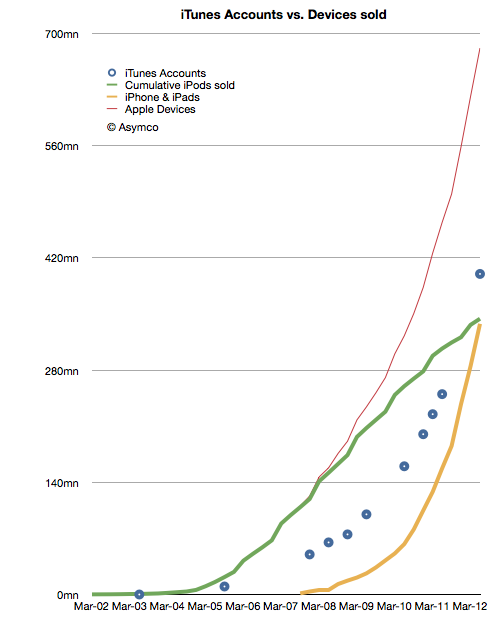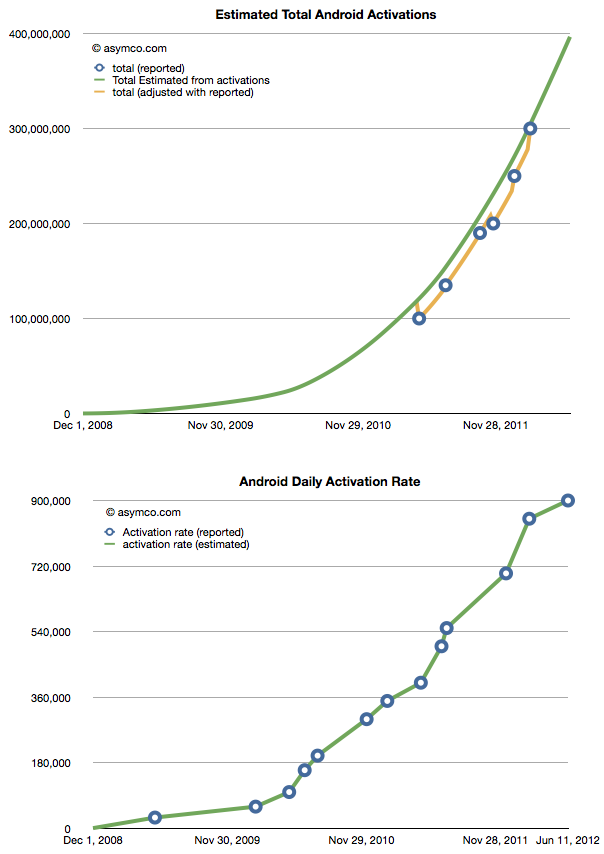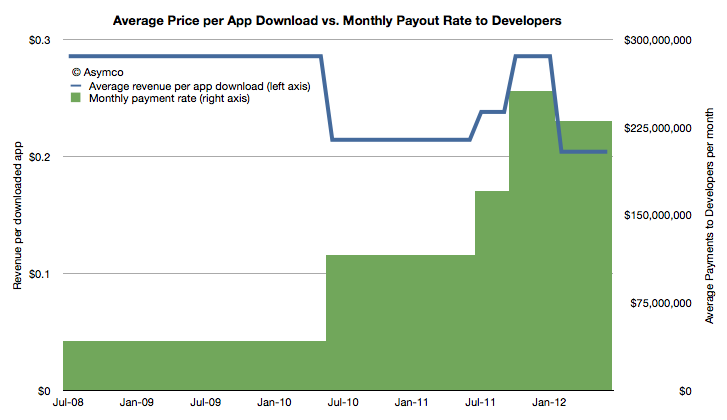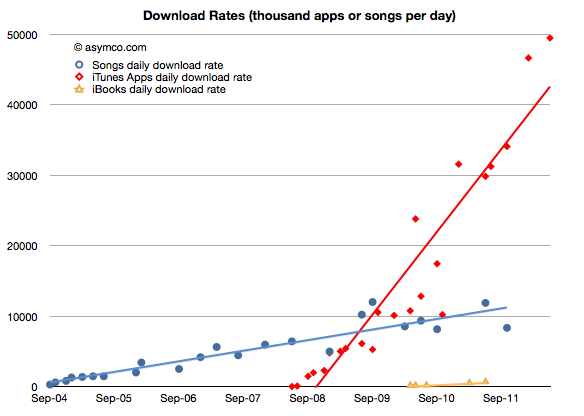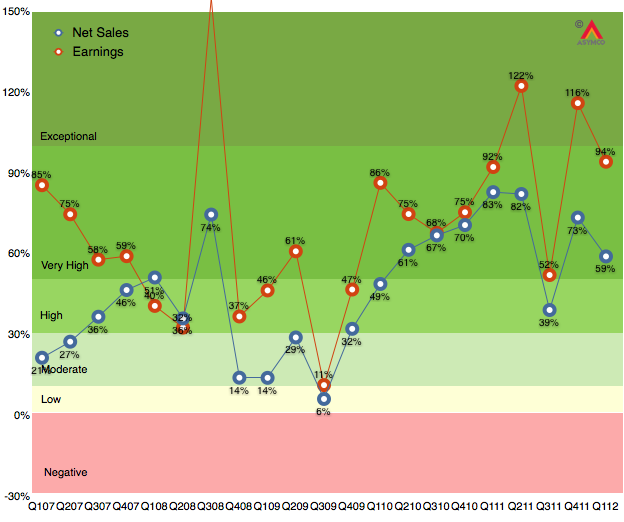What topics would you like to have me discuss on The Critical Path podcast? Put forward your questions as comments below. If you see a question already asked, vote for it by marking it up.
A more precise measure of Apple's device installed base (and device longevity)
Apple announced that the total number of iTunes account (with credit cards attached) has reached 400 million. This was touted as being the largest collection of credit card accounts for any retailer and I have no reason to doubt it. However, looking beyond the bragging rights, there are more interesting patterns to observe about this asset.
What I plotted was the cumulative number of iPods sold (green), the cumulative number of iPhones and iPads (yellow), the combined devices total (red) and the reported number of iTunes accounts (blue). Continue reading “A more precise measure of Apple's device installed base (and device longevity)”
Update on Android growth
In February of this year MediaTek introduced an ARM chipset for Android smartphones targeting $160 end user pricing. I’ve heard estimates that this chipset will sell in the “hundreds of millions”.
The question is: are these units going to be “activated” as per Google’s definition of Android?
Historically, MediaTek’s chips have been used in “grey market” devices. These are typically copies of branded phones and are sometimes shipped without IMEI numbers and hence not even sanctioned by regulatory authorities. If hundreds of million of such Android devices are sold in the next few years then tracking Android will become even more difficult.
The current total is difficult enough. We just received an update on the activation rate (900,000 per day) and that allows us to create a picture of total cumulative activations.
We still don’t know the retirement rate so these are not devices in use, however Continue reading “Update on Android growth”
Are revenues per app decreasing?
Apple has been releasing data about payments to developers with increasing frequency. Last week’s $5 billion announcement was the fifth such update and came after about one quarter since the last.
Knowing the payments to developers and the cumulative download count allows us to get a very accurate revenue point for each download. As the frequency increases we can observe growth and seasonality patterns.
The following chart shows how average revenue per app download and the average payment rate to developers has changed since the iTunes app store opened and given the data points available:
The green area in the chart should add up to $5 billion. The average revenue for all downloads is 24c. Continue reading “Are revenues per app decreasing?”
5by5 | The Critical Path #42: Full Circle
Having just returned from China, Horace gives his impressions which leads to a discussion about industrialization and innovation and how countries “mature” and what is Apple doing in China and the new relationship between Apple and strategic partnerships and the new stats from WWDC 2012 about developer revenues and how that differs from Android and the 400 million Android devices activated vs. 400 million iOS devices built, in China.
The iOS App market sales run rate is $4 billion per year
At the 2012 WWDC, Apple released new data concerning its App ecosystem. Namely:
- 30 billion apps downloaded to date (excluding updates)
- $5 billion paid to app developers
- 400 million iTunes accounts
These three data points allow us to update our picture of the app economy. First, the app download rate.
As would be expected from an expanding user base, the app download rate has been increasing. It is now at about 49.5 million apps downloaded every day. The history of this rate is shown in the chart below:
I added the same data for iTunes songs and book downloads for comparison. Note that although music and books are available to the same user base (actually higher due to Macs and iPods which do not run apps,) apps are being downloaded at a far faster rate–at least four times faster.
In terms of total, cumulative downloads, the comparison is even more stark: Continue reading “The iOS App market sales run rate is $4 billion per year”
The Critical Path: The First Year by Horace Dediu — Kickstarter Funding Successful
I extend a heartfelt thank you to all 831 backers of my first Kickstarter financed book project. Thanks to you not only will there be a way to refer to and cite the podcasts but, since the project reached 980% of its target, the project allows me to explore new means of publishing and content production.
Clay Christensen said that a disruptor should be patient for growth but hungry for profit. The Asymco experiment is continuing and is staying true to this principle.
The Critical Path: The First Year by Horace Dediu — Kickstarter.
Estimates for Apple's third fiscal 2012 quarter
As the chart below shows, the last quarter (first calendar 2012, second fiscal 2012) was robust with 94% earnings growth and 59% net sales growth. Subject to the usual superlatives, the performance was, again, unexpected by many.
Much of that surprise was due to the underestimation of iPhone sales in China during what is a holiday quarter in that nation. Growth this quarter will be more difficult to estimate. The iPhone is still the most important component but the iPad is becoming increasingly decisive in overall performance. In fact, I’m projecting that the iPad will have the equivalent of 73% of the iPhone revenues this quarter. Continue reading “Estimates for Apple's third fiscal 2012 quarter”
5by5 | The Critical Path #41: Contextual Inquiry
Dan and Horace talk about the distinction between what Facebook is and what its value is perceived to be. We touch on both the opportunities and the challenges for social media and how these are reflected in the IPO. We note how and why Facebook integration in iOS might happen. Horace has a few words about China, WWDC, and the future of apps on TVs. It’s all about context.
5by5 | The Critical Path #41: Contextual Inquiry.
Asymmetric competition | Horace Dediu | Mobilism 2012 on Vimeo
Here is a video of my presentation at Mobilism 2012 on the story of mobile phone disruption. Thanks to Peter-Paul Koch (aka PPK) for organizing a great event and allowing me to present to such a smart and knowledgeable audience.
Asymmetric competition | Horace Dediu | Mobilism 2012 on Vimeo
Nearly one third of the time is spent in Q&A, which, even if I do say so myself, is the best part.
Also note the exclusive use of a custom iPad app for wireless presentation (pre-release version of the Perspective App.)

